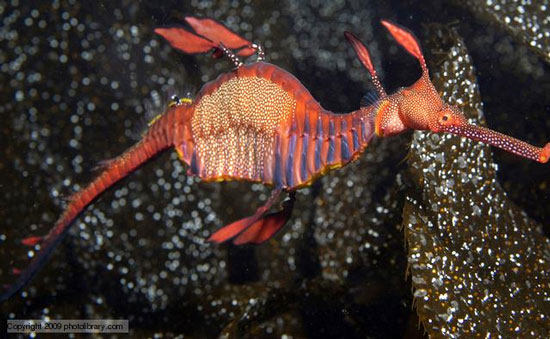New discovery of the reproductive behavior of sea dragon fish
Australian scientists have discovered that weedy seadragon has unique signs and males often focus on individual groups "pregnant."
Dr. Keith Martin-Smith of the University of Tasmania spent more than two years taking photos of the sea-grass sea arowana distributed in the southern waters of Hobart, the state capital of Tasmania.
He discovered that independent male males often grouped into groups after breeding and called these "kindergartens" because that is where male sea arowanas swim around while taking care of young . All males carrying eggs usually gather in small groups within a few meters.

Sea dragon fish with grass
Dr. Martin-Smith used a pattern recognition software to recognize the signs on the sea arowana's body, thereby finding pregnant males gathered in clusters.
This sea creature has very beautiful dots along the body and each individual has its own speckled patterns. These patterns are like fingerprints in humans, except that it can be more complicated.
He hopes to build a database that interacts with the public via the Internet to contribute to the conservation of the endangered sea grass species.
Sea arowanas have relatives of sea horses and like their relatives, the male is responsible for pregnancy.
Females produce about 200 pale pink eggs and then put them into the male's tail through a pipe. The eggs will stick to the oxygen supplies in the male's tail. Depending on the surrounding water conditions, the eggs will turn purple and start to hatch after about eight weeks.
After this period, the male "tummy" pushes the fry off the tail. This process takes about 24-48 hours and individual children have been independent since then.
Martin-Smith said the study will help scientists build models of sea arowana populations to protect this strictly protected species.
- Many fish species are 'agitated', changing mating behavior because of chemicals discharged into the sea by humans
- Some fish species live in the harshest place on earth
- Listed 10 fish species that have a talent for terrestrial hunting in the natural world
- Fish are also right, on the left as human
- What is special about arowana?
- Fossils of 50 million years of the ancient fish herd nearly 300 children
- 'Voting' method of fish
- Five Komodo dragons were born by a simple reproductive pathway
- 'Husband-free' snake
- CO2 emissions alter the behavior of marine fish
- The species is transsexual in Antarctica
- The super rare ruby sea dragon rose to form for the first time in history
 Animal 'suffering' after hibernation
Animal 'suffering' after hibernation Why do goats climb well?
Why do goats climb well? Scientists were surprised to see chimpanzees eating turtles
Scientists were surprised to see chimpanzees eating turtles Giant catfish died deadly due to drought in Thailand
Giant catfish died deadly due to drought in Thailand